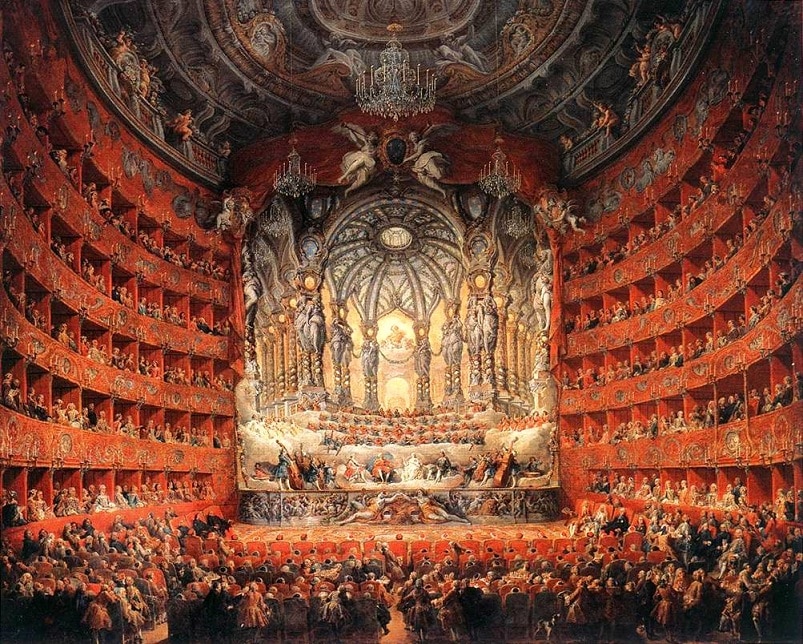
In terms of Western Art, the Baroque period followed the Renaissance and is broadly agreed to cover the years from 1600 until around 1750 when the Classical period began. What we discover when we look closely at the characteristics of this period of musical history is that flows as a natural progression from the one that came before.
Many of the forms, structures and conventions of the Renaissance provide the basis for the new Baroque style and sound. In this article, I will briefly outline some of the key features of the Baroque period of music to give an idea of what to listen out for.
Read also:
- Characteristics of Classical Music
- Characteristics of Romantic Era Music
- Characteristics of Renaissance Era Music
Characteristics of Baroque Music
For many, the splendour of the Baroque age epitomises grandeur and elegance. Baroque music is a great favourite for weddings and celebratory occasions, for good reason. Many pieces that have endured as our musical favourites from the Baroque period are truly magnificent and mirror the opulence of the period’s architecture and fine art. This holds true for both the sacred and secular works of the period whose majesty and guilt-edged ornamentation still appeals.
Many musical forms that we recognise today in western classical music were current during the Baroque too. The Concerto was an immensely popular musical form and the Concerto Grosso.
Essentially the key difference between these two types of music is that the Concerto Grosso was composed for a group of soloists (the concertino), and an accompanying orchestra or ensemble (the ripieno), whereas the concerto would most usually be a single soloist and orchestra. The number of movements could vary but regularly followed a fast, slow, fast pattern and often was based on earlier Renaissance dance forms.
Vivaldi and Corelli are often considered to be two Baroque composers who have made the greatest contribution to these musical forms. Vivaldi is perhaps better known today for his dramatic depiction of the seasons in his “Quattro Stagioni”, or Four Seasons. For Corelli the 12 Concerti Grossi, Op. 6 are amongst the best of the period. Corelli was also a master of the trio sonata that grew from the Renaissance canzona and featured two violins plus a continuo.
Courtly dances that featured in earlier music now began to provide the basis for instrumental pieces in the Baroque. These came from across Europe and were influenced by Germany, France and Italy in equal measure. The Baroque composers took these dances and developed them into pieces in their own right, without the need for the dancers although the feel of the dance clearly remains.
Common Renaissance dances that Baroque composers crafted into instrumental “Suites” would have included the allemande, the courante, the gigue, and the sarabande. Each dance had a contrasting feel and meter. The allemande would be in a moderate four, whereas the sarabande a slow three. The J.S. Bach English, French and German Suites illustrate this point succinctly.
Like every period of musical history instrumental development took centre stage. The viol, (a predecessor to the modern violin), was discarded in favour of the new more expressive and dynamic, violin. It was largely Catherine Medici who funded the instrument’s development with masters like Stradivari creating instruments that are still sort after by today’s performers.
The harpsichord became the backbone of most ensembles and in conjunction with the celli or occasionally double bass, formed what was known as the continuo. (An accompanying part that supported the melodic lines by providing harmony and rhythm). Flutes, oboes, trumpets (without valves), and timpani all became established members of what would eventually develop into the symphony orchestra we recognise today.
As the quality of the instruments developed composers increasingly exploited the greater dynamic range. Antiphonal music was common where dramatic contrasts between quiet sections of music sat softly against strong, forte parts. These dynamic variations were an important feature in much music of the Baroque.
Choral music was not neglected in the Baroque period. Sacred music formed a significant part of most Baroque composer’s workload. The Mass, the Cantata and to some extent the Oratorio were fully established as cornerstones of major composers like Bach (St Mathew’s Passion and Mass in B Minor), Handel (Messiah), Vivaldi (Gloria: RV589).
Henry Purcell should not be overlooked in terms of sacred Baroque music with his substantial collection of anthems and devotional songs. On the other side of Baroque vocal music, Purcell was also beginning to explore the concept of opera. “Dido and Aeneas”, by Purcell are considered by many as the first example of a full opera written in the period.
Keyboard music became a regular part of the musical diet during the Baroque. Even though the harpsichord itself was a notoriously unreliable instrument that quickly slipped out of tune, numerous pieces were composed for it and its rival, the organ. Scarlatti, and Italian composer wrote extensively for the keyboard and produced a dazzling array of (mostly one movement) sonatas. Bach’s most famous keyboard works could be thought of as his 48 Preludes and Fugues.
Many of these keyboard works demonstrate the qualities that were common in the period. Bach’s fugues are a highly complex musical form with interweaving melodic lines that create dense and beautiful textures.
In musical terms, this is referred to as polyphonic (many sounds). Another feature of these pieces is the counterpoint. This type of musical writing stems from the Renaissance where if one line of music goes up the other goes down at the same time.
An additional characteristic that is important to listen for in Baroque music is sequence and imitation. The word sequence refers to a certain progression of chords during a section of music that usually follows an easily recognisable pattern.
It is employed for colour in the music and to sometimes to seamlessly change key. Vivaldi I consider the master of this and he uses it to great effect in many of his works. Imitation in musical terms is as the word suggests; imitative, where you can hear passages of melody pass from one instrument or voice to another sometimes as a perfect copy.
As a starting point in your discovery of the music of the Baroque try some of these pieces:
J. S Bach – 48 Preludes and Fugues, St. Mathews Passion, Any of the Brandenburg Concertos
G.F. Handel – The Messiah Concerti Grossi, Op.3, Music for the Royal Fireworks
Vivaldi – The Four Seasons, L’estro armonica, Stabat Mater

This article is quite helpful and insightful. thank you for this.
Does the baroque trill begin with the note above or from below?
This work has been very helpful, thanks.